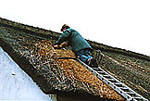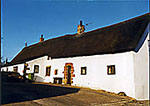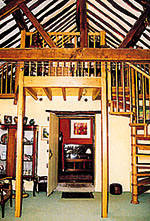

 |
Telephone 01228 710071





Curthwaite stands at the edge of what was once Inglewood Forest, mainly oak, and a rich source of material in centuries past. "Thwaite", a common place-name suffix here, signifies a clearing in the forest; the suffix "by", as in nearby Thursby, and a crop of village names immediately to the north of Curthwaite indicates the edge of a forest. It is easy to forget, now that the primary forest has disappeared, that it must at one time have served to protect these old buildings from the worst of the south-westerly weather.
The restoration
The previous owner, Ian Laval, a furniture maker, felled and sawed the local oak for replacement roof timbers and internal joinery. While the original roof timbers have been restored and are visible inside the house, a new thatch covering has been laid on an independent roof above the old one. Eleven tons of reed were imported from Hungary for the new thatched roof. The old wheat straw roof had been covered by corrugated iron in 1916.
All internal plaster and external render was made from lime slaked on site, with cow tail hair and cow manure added according to old recipes. Almost half a ton of muck went into the plastering and rendering!
Whatever joinery has been replaced at Meadowbank Farm, the timber has come from local trees, and surviving patterns of doors and frames copied. Internal doors, wider and lower than modern ones, have been made from local cedar or Scots pine, with random, wide boards half-lapped together and one edge at the joint beaded. Scots pine and larch were used for surviving doors, one complete with its original beech-cased lock, still in working order. No diagonal bracing was used, only battens chamfered all round, and the boards fixed with clenched, cut clasp nails. Door frames are in local oak, squarish in section, about three or four inches, and fixed under the head with simple tenons and oak pins. The original joiners never bothered to dress the heads of their pins flush.
The history
The house
was occupied in the 17th Century by the family of John Losh, a farmer,
whose descendants remained
in the house for at least a hundred years. A 1666 date stone over the
front door bears the initials
of John and his wife, Dorothy. John Losh's will, 1692, is in the local
historical archives. The
single pair of crucks visible in the middle of the house were inserted
by John Losh in what had hitherto
been a simple clay house and barn with roof supported by clay cross walls.
It
appears that some geological disturbance may have taken place after John
Losh's 17th Century improvements;
the stone lintel at the western end of the cross passage has sunk by several
inches at
one side and the eastern elevation tilted seriously out, which was remedied
by the installation of three
very large stone buttresses.
E-mail:SueGlassfordArt@aol.com